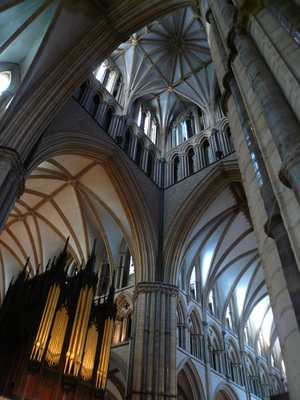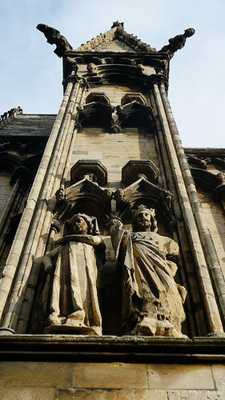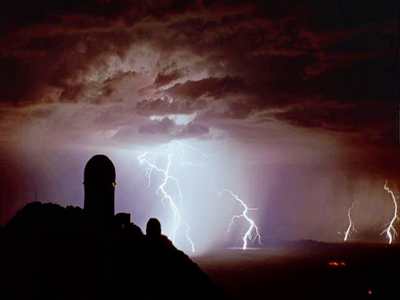Gothic Marvels and Supernatural Wonders: Lincoln Cathedral’s Hidden Stories
Lincoln Cathedral: Embarking on a meticulous exploration in 2005, I delved into the enchanting realm of Lincoln, England’s Gothic Cathedral. Describing it as merely splendid would be an understatement. Its towering 271’ central spire, England’s second tallest, dominates the skyline, visible up to thirty miles away.
This architectural marvel, once the world’s tallest structure from 1300 to 1549, surpassed even the Great Pyramid of Giza. My investigation unexpectedly uncovered the ‘Lincoln Cathedral Code,’ weaving connections to Rennes-le-Chateau, Mary Magdalene, and the Knights Templar. Little did I know, the Cathedral had long attracted peculiar notions before my revelations.

The earliest reference linking the Cathedral with the Devil surfaced in the 1898 ‘Lindsey and Lincolnshire Star.’ An article titled ‘Lincoln Minster and the Devil’ mentioned the longstanding proverbial connection between the Prince of Evil and Lincoln. A grotesque figure, known as ‘the devil looking over Lincoln,’ adorned the chapel’s gable, baffling researchers.
The legend took a bizarre turn, describing the devil as inside the Minster, fearing exposure to the outside lest he be blown away. Conflicting with the 13th-century tale of the Lincoln Imp, my research highlighted the persistent association of Satan with the Cathedral.
A village legend from Kinoulton in Southeast Nottinghamshire narrates the Devil hurling a stone from Lincoln Cathedral at a church. While folklore often reflects the clash between early Christianity and paganism, the story raises questions about the Cathedral’s role in this diabolic act.
Even the Cathedral’s Rose Window, named ‘Lucifer’s Eye,’ challenges norms. Placed on the North side, opposite the usual West placement, it is associated with the darkened region of Lucifer, guarding against evil.

A tantalizing tale, circulated on the internet, introduces ‘The Ark of Lucifer.’ Allegedly hidden in the Cathedral, this artifact is said to control human lifespan through vibratory frequencies at the molecular level. The intricate procedure to unlock this mysterious Ark involves a Master Key, 12 valid keys, and a vault within the Cathedral.
The Cathedral’s esotericism doesn’t end there. Richard Leviton, in his 1991 article ‘A Précis of Albion,’ links Lincoln Cathedral to a giant cosmic being. Another unexpected revelation comes from the Cathedral’s former Dean, Rev Brandon Jackson, who believed in a battle of good and evil centered on the ancient Minster. Jackson, acquitted of sexual misconduct accusations, even sought to exorcise the Cathedral.
In a Sunday Times article from 1995, Rev Jackson’s claims of an ‘evil force’ within the Cathedral became national news. His description of currents of conflict, hate, and evil swirling around the Cathedral stirred controversy.
These diverse accounts, ranging from the Devil within to an Ark of Lucifer, prompt contemplation. While some may dismiss them as fanciful, the recurring theme raises questions about the Cathedral’s mystique. The collective narrative suggests a battleground between forces of light and darkness, echoing Rev Jackson’s convictions.
Ending with a personal anecdote, a woman named Sylvia recounted a nightmarish encounter with the Devil during a spiritual retreat at the Bishops Palace facing Lincoln Cathedral. This incident, shrouded in trauma, parallels Rev Jackson’s claims and adds another layer to the enigma surrounding Lincoln Cathedral.
As I conclude, I find myself not alone in navigating the labyrinth of mystique surrounding Lincoln Cathedral. The threads of these narratives, woven across centuries, converge in a captivating tapestry of the sacred and the occult.
Gothic Cathedral of Lincoln, England

Lincoln Cathedral stands as a monumental testament to the grandeur of English Gothic architecture. The soaring spires and intricate details of this awe-inspiring structure exemplify the pinnacle of Gothic craftsmanship. Erected in the 11th century and later expanded in the 13th century, Lincoln Cathedral showcases the evolution and refinement of English Gothic architecture over the centuries.
The elaborate stone carvings, pointed arches, and ribbed vaults that characterize Gothic design are masterfully manifested in every nook and cranny of this iconic cathedral. The central tower, reaching a height of 271 feet, once held the title of the world’s tallest building from 1300 to 1549, surpassing even the Great Pyramid of Giza. Its prominence in the Lincoln skyline makes it an enduring symbol of medieval architectural prowess.
Beyond its architectural splendor, Lincoln Cathedral has accumulated a wealth of stories and legends that add an intriguing layer to its historical tapestry. The enduring tale of the Lincoln Imp, a mischievous creature turned to stone by an angel, captivates visitors and symbolizes the eternal struggle between good and evil. Furthermore, the mysterious link between the cathedral and esoteric narratives, such as the ‘Ark of Lucifer,’ adds an enigmatic dimension to its narrative. The Cathedral has been a focal point not only for architectural enthusiasts but also for those intrigued by the intersection of history, myth, and spirituality.
Exploring Lincoln Cathedral becomes a journey through time, where each stone and arch tells a story of medieval craftsmanship, religious symbolism, and the enduring mystique of English Gothic architecture. As one navigates its hallowed halls, the cathedral becomes a living classroom, imparting lessons on the evolution of architectural styles and the cultural significance of this splendid example of English Gothic heritage.

